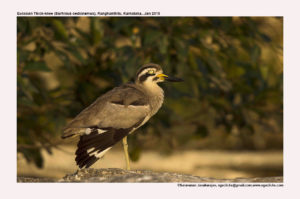Eurasian Thick-knee

Eurasian Thick-knee Burhinuso edicnemus
Etymology:
- Burhinus : Greek word bous- ox; rhinos –nose
- Oedicnemus : Greek word oideosswelling ; kneme -leg
Vernacular Names: Hindi: ChotaKarwanak, Barsiri, Sans: Girinaktkurri, Pun: Karvank, Ben: Kharma, Chhotashilabatan, Guj: Karachala-kha, Chakva-chakvi, Nano chadvo, Mar: Pikwik, Dhanchuwa, Ta: Musalkozhundu, Kanalmosal, Kannadi al katti, Te: Kalleydu, Raatikaledu, Mal: Valyalkannan, Sinh: Golukiraluwa/kirala
Distribution inIndia: Widespread resident in India.
Description: Size:40-44cm. It is sandy brown with white belly and vent, upperparts streaked darker; head finely streaked dark, with whiter lores, line above eye and broad band from upper mandible beneath eye to rear cheek; dark malar stripe; white chin and throat; breast heavily streaked blackish; upperwing-coverts marked by parallel bands of dark brown and white, with black lower border; inner primaries have square white patch at base and fine white tips; outer primaries have white central patch; bill yellow with black tip; eyes yellow; legs pale yellow-buff.Both the sexes are similar.
Habitat: It is found in semi-arid, arid and steppe grassland, woodland, heath, fields with bare, stony patches, coastal dunes and shingle; also short-grass plains, stony plateaux, and semi-desert. Requires open, level ground with sparse vegetation cover, where running is easy.
Food Habits: It eats invertebrates and small vertebrates: insects and their larvae, especially beetles, grasshoppers, crickets, ants, earwigs, caterpillars and flies; also earthworms, slugs, snails, small rodents and reptiles, including poisonous snakes; occasionally some seeds.. It is mainly nocturnal and exclusively terrestrial feeder. It walks slowly along in search of prey, taking prey with bill. It uses sudden, short run to capture prey, or a swift lunge, or simply picks less active prey from the ground with deft movement; also leaps to catch moths, and takes insects from vegetation. It forages singly, in pairs or small groups.
Breeding Habits: They breed Feb-JulyinIndia. They are monogamous & territorial. The nest is a scrape in ground , lined with a little grass or unlined, but often with a ring of stones or shells and pieces of vegetation around rim, often by fallen branch or small bush. They lay a clutch of 2 eggs . The incubation period is 24-27 days and chick care done by both sexes. The fledging period is 36–42 days.